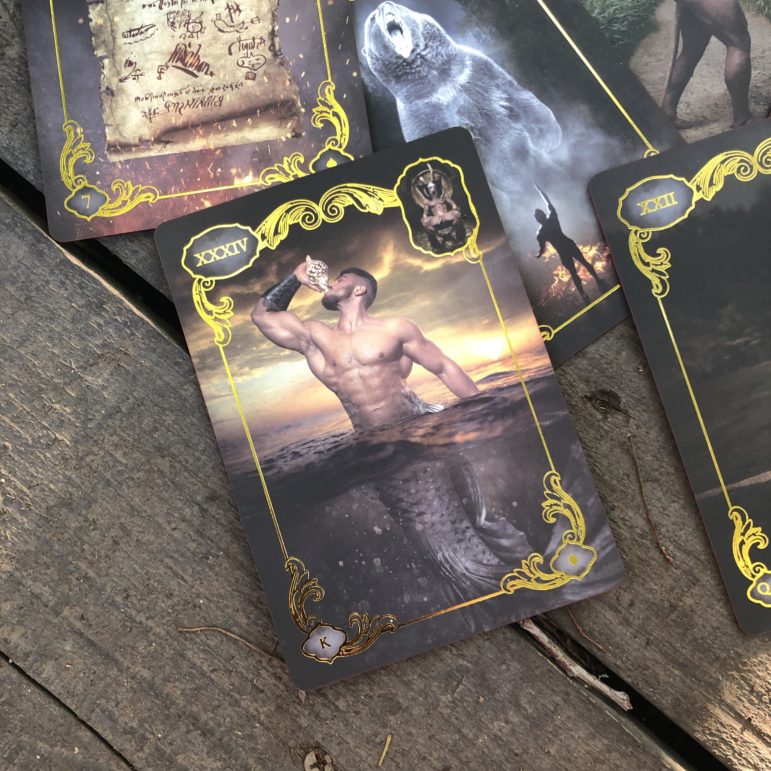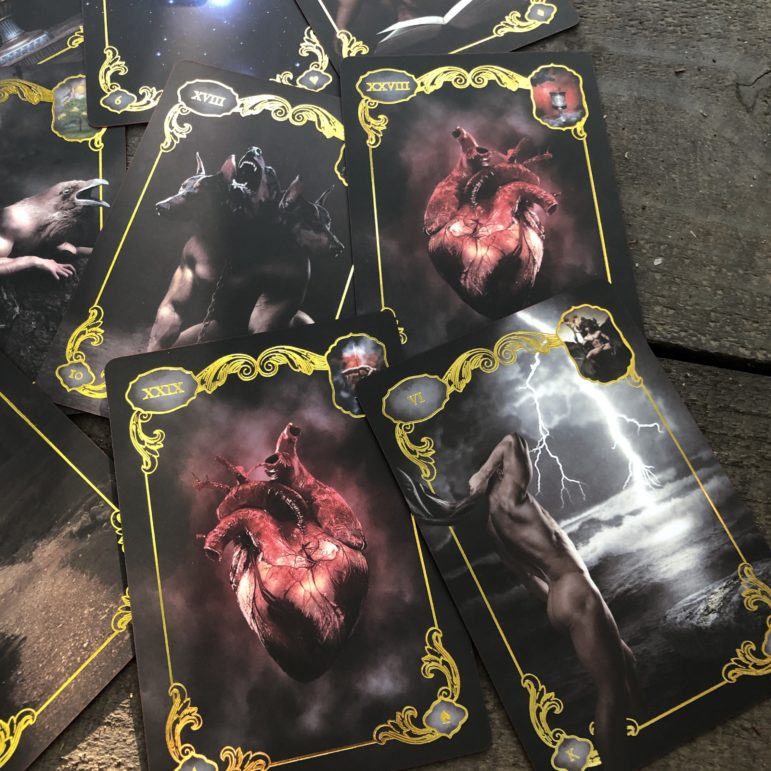
Today’s article is effectively a follow-up to my December 2020 column, in which I reviewed the (sinister and sexy) Sabbath Tarot from artist and photographer Allan Spiers and author Jeff Cullen. I finally got my hands on a copy of their eagerly awaited “sequel” to that deck – The Sabbath Lenormand – and I can’t wait to share it with our readers.

The Sabbath Lenormand [Allan Spiers]
I will admit that I have been excited to see this deck finally come to fruition. Several months ago, I supported it on Kickstarter to help ensure it became reality, and I am so glad I did. (The deck I received went to my husband Chas as a birthday present, and I fear that I may now have to order myself one of my own.)
Several years ago, I started reading Lenormand cards professionally, and it really changed how I do my readings. For those who are not familiar, the Lenormand is a 19th century French cartomancy system erroneously said to have been designed by the late Mademoiselle Marie Anne Lenormand (1772–1843), who was then the world’s foremost psychic. She allegedly had a long list of important and “celebrity” clients, including Empress Josephine, wife of Napoleon, for whom she read regularly. She reportedly didn’t even like using cards for readings, preferring instead to rely on her natural psychic talents when a client’s expectations didn’t force her to “play the part” of a card reader.
After her death, however, card decks began to be printed using her name, and one of them, a 36 card deck marketed at the time as Le Petite Lenormond, became the most popular. This deck is what most Lenormand decks are based off of today. These were based off a card game at the time, the “Game of Hope,” in which each card had an archetypal symbol. These are the symbols that we find in Lenormand decks today, such as the House, Dog, Ship, Book, and so on, and the interpretations of them are similar to what one might find in tasseomancy, the art of reading tea leaves.
In practice, the reading of Lernormand tends to be more straightforward than its cousin, the tarot. While tarot (nowadays) tends to focus more on one’s spiritual development than on concrete events, the Lenormand seems to revel in its status as a “fortune telling” system. While the real difference lies in the reader themselves, how popular readers and authors have presented their approaches to the cards have greatly influenced how they are approached by “the average reader.”
The Sabbath Lenormand is a beautiful addition to the collection of Lenormand and cartomancy systems. Continuing his “Sabbath Project”, Spiers unveils another stunningly beautiful deck. Again, it is of the highest quality. The images are both striking and flawless. Spiers’s use of light and muted tones sets the stage for this to be another underworld journey, perfect for Witches who wish to evoke that mood of darkness, beauty, and mystery.
The imagery is homoerotic, dark, and sensuous, transporting us to the Witches’ Sabbath, that shadowy celebration of the carnal path to spiritual potency. This is definitely a cartomancy deck meant for Witches.

Shedding some light on The Sabbath Lenormand [Allan Spiers]
The erotic imagery is beautiful, sexy, and very well done. Spiers, being a fitness photographer, has chosen models that represent the societal standard of male beauty: lean, muscled, strong. One criticism of this style that I have heard since my review of their previous deck is that using only these body types doesn’t help to expand the ideal of male beauty. While certainly as a society we have a lot of work to do in order to make the “all bodies are beautiful” slogan a reality, to criticize this work for that social failing is quite frankly missing the magical point.
Drawing from Greek idealism, and combined with the artist’s and author’s passion for fitness and bodybuilding, the painstakingly crafted muscles of the male form depicted here are a physical metaphor for putting will into action, the “hard work” that must be done in occultism in order to develop one’s skill and power. This shouldn’t be taken as a statement that only these types of bodies can represent that process of thought, but just that this is what the artist finds attractive and speaks to his artistic fire. (I personally would welcome a Witches’ Deck of Faerie Bears, sometime. Get to it, queer artists!)
The card stock for this deck is heavy and strong. Each card has an embossed gilded border that not only depicts which playing card is traditionally associated with that Lenormand image, but also has inset an image of a tarot card from the Sabbath Tarot, linking these two decks and creating the possibility of interlocking divination systems that will have you delighting at your next divination party.
The booklet that comes with the deck, written by Jeff Cullen, is hardcover, and not only presents divinatory meanings for each card, along with some spreads, but also suggests spellwork to go along with each card. The deck comes in a heavy-duty cardboard box that is styled in the fashion of an antique jewelry box. Upon opening, we are greeted with an image of Lenormand herself, now perhaps a presiding spirit lending the momentum of her legacy to the readings done in her name. It all fits into the blue drawstring pouch provided, marked with the Sabbath logo, the red inverted pentagram.

I’ve never found the “Fish” card to be sexy until now. (In the back we also see “Bear” and “Letter,” here as the Devil’s Pact.) [Allan Spiers]
A couple of changes from the traditional deck stick out here. Card VI is usually Clouds but here is Storm. This encapsulates the more traditional meaning of the card (obscurity and confusion) and adds to it a warning of danger, or even illness that can be avoided. Card XII is Bird, and here it is the same, only depicted as a male witch in mid-transformation into the winged creature!
Card XIII is still Child, but here shown as the Devil, to whom it is said that witches would offer children as symbols of innocence. Card XIV is still titled Fox, but here is a flying fox, in keeping with the nocturnal theme of the deck and offering a really innovative reinterpretation. Card XVIII is the traditional Dog, but not depicted in the a traditional way: here Dog is a muscle man with the three heads of Cerberus. (Down boy!) Card XX is Garden, but here presented as a nude field worker reaching below to the undead hand reaching upward.
Card XXII, usually Path, is here as Crossroads, and it’s about time! This card’s traditional meaning speaks of big decisions to ponder, and uncertainty, a state that simply screams “standing at a crossroads.” This is the perfect name for this card. XXVI is still Book, but here depicted as the witch’s grimoire, and the demonic familiar behind its seductive power.
With XXVIII and XXIX we see Lenormand joining the 21st century. Traditionally “Man” and “Woman”, respectively, here they are both labeled “Person,” and we are offered gender-neutral imagery for both: two views of a human heart. While the first is said to carry more active or “masculine” energies and the second more passive or “feminine,” the real definitions are left up to the reader and client, making this a much more inclusive system in regard to ones’ actual or perceived gender identity – a welcome change.
XXX, normally Lily, is here as Flower, and depicted with one of the Witches’ favorite blooms: the datura. Maturity and wisdom, as well as sexuality and lust, are the definitions for this card, which draws from both traditional meanings as well as some more modern takes. XXXIV is Fish, but is here illustrated as a hunky merman, making me long for a life at sea. The divinatory meaning is as with the traditional – money, riches, fortune. XXXV is Anchor, but while the traditional depicts a ship’s anchor, here we are witness to a Witches’ anchoring spell involving railroad spikes driven into the ground in order to secure remaining in a property.
Finally, XXXVI, what is normally the Cross is here as Pentagram. With much of the divinatory meaning intact – spiritual power, sacrifice, destiny – we are treated to the use of one of our own religious symbols that conveys deep meaning and reverence. This final reinterpretation solidifies this deck as being one made by Witches for Witches to use.

“Dog,” the two “Person” cards (represented by hearts), and “Storm.” This is fine art as a divination system. [Allan Spiers]
The three spreads given in the book are simple and meaningful. The first two are unique (“The Key” and “The Crossroads”) and offer the reader meaningful opportunities to delve into the heart of a matter. The third is a spread that all Lenormand fans will recognize: The Grand Tableau. This is a traditional spread that uses all 36 cards in the deck and is given here with a modern streamlined approach. Traditionally a Grand Tableau is laid out with three rows of eight cards and a final row of four, but here is given as an even 6×6 grid.) Since my own reading practice sees me using an even grid of cards as well, I was very happy to see this.
All in all, The Sabbath Lenormand will be a great addition to any Witches’ collection of divinatory tools, or even just as a collectible art piece. It is beautiful, informative, and deliciously witchy. I rate it at five pentagrams.
The Wild Hunt always welcomes guest submissions. Please send pitches to eric@wildhunt.org.
The views and opinions expressed by our diverse panel of columnists and guest writers represent the many diverging perspectives held within the global Pagan, Heathen and polytheist communities, but do not necessarily reflect the views of The Wild Hunt Inc. or its management.
The Wild Hunt is not responsible for links to external content.
To join a conversation on this post:
Visit our The Wild Hunt subreddit! Point your favorite browser to https://www.reddit.com/r/The_Wild_Hunt_News/, then click “JOIN”. Make sure to click the bell, too, to be notified of new articles posted to our subreddit.